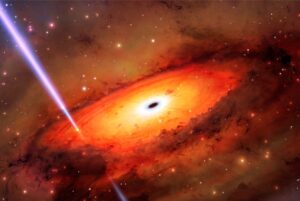Never-before-seen scenario suggests a new way to destroy a star

Artist’s Impression of a gamma-ray burst. Credit: International Gemini Observatory/NOIRLab/NSF/AURA/M. Garlick/M. Zamani
While searching for the origins of a powerful gamma-ray burst (GRB), an international team of astrophysicists may have stumbled upon a new way to destroy a star.
Although most GRBs originate from exploding massive stars or neutron-star mergers, the researchers concluded that GRB 191019A instead came from the collision of stars or stellar remnants in the jam-packed environment surrounding a supermassive black hole at the core of an ancient galaxy. The demolition derby-like environment points to a long-hypothesized — but never-before-seen — way to demolish a star and generate a GRB.
The study will be published tomorrow (June 22) in the journal Nature Astronomy. Led by Radboud University in the Netherlands, the research team included astronomers from Northwestern University.
“For every hundred events that fit into the traditional classification scheme of gamma-ray bursts, there is at least one oddball that throws us for a loop,” said Northwestern astrophysicist and study co-author Wen-fai Fong, “However, it is these oddballs that tell us the most about the spectacular diversity of explosions that the universe is capable of.”
“The discovery of these extraordinary phenomena within dense stellar systems, especially those encircling supermassive black holes at the cores of galaxies, is undeniably exciting,” said Northwestern astrophysicist and study co-author Giacomo Fragione. “This remarkable discovery grants us a tantalizing glimpse into the intricate dynamics at work within these cosmic environments, establishing them as factories of events that would otherwise be deemed impossible.”
Fong is an assistant professor of physics and astronomy at Northwestern’s Weinberg College of Arts and Sciences and a member of the Center for Interdisciplinary Exploration and Research in Astrophysics (CIERA). Fragione is a research assistant professor in CIERA. Other Northwestern co-authors include Anya Nugent and Jillian Rastinejad — both Ph.D. students in astronomy and members of Fong’s research group.
Continue to the full Northwestern News story.

